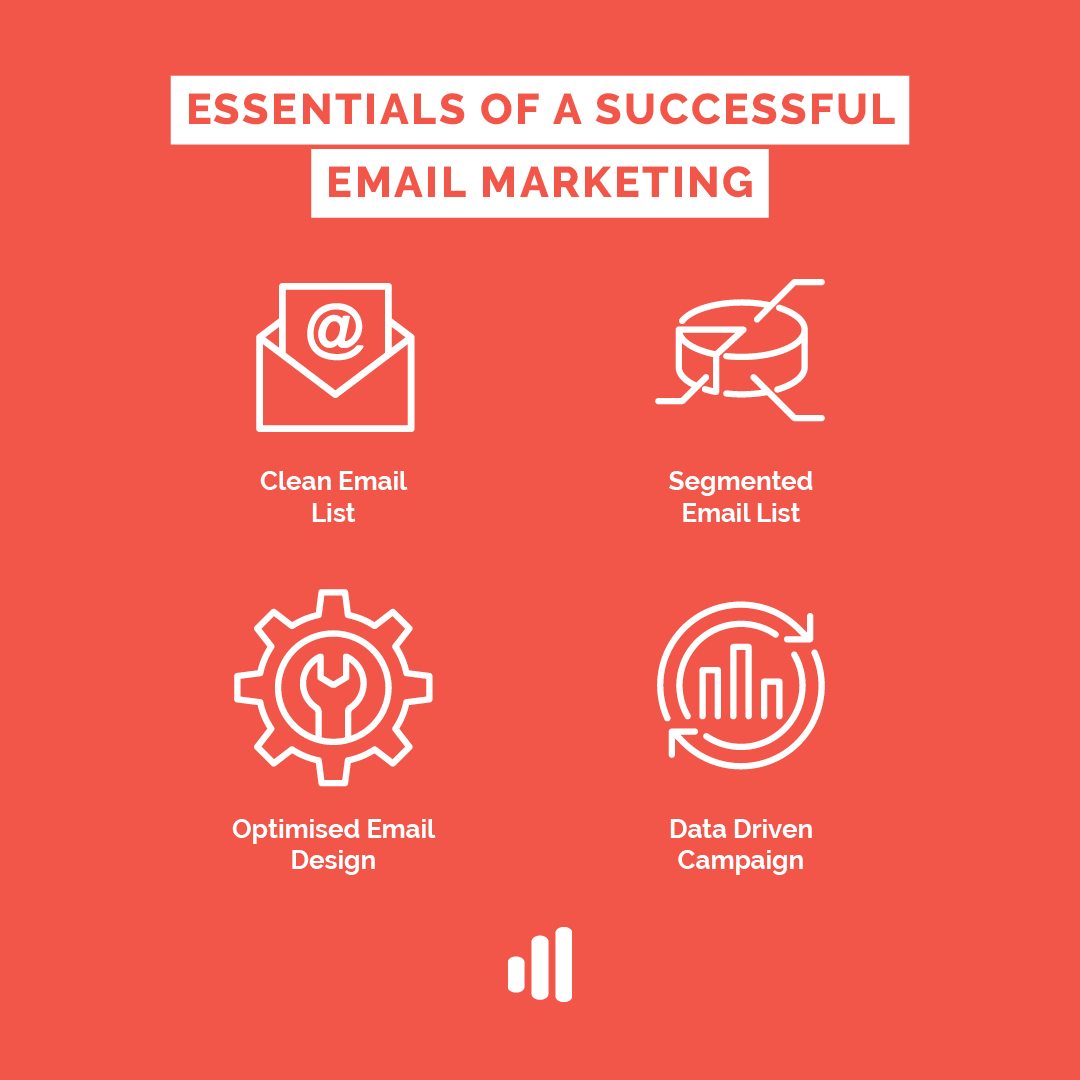Let’s discuss the four components of a successful email marketing campaign and run through actionable tactics to improve your email marketing performance.

1. Clean Email List
Maintaining a high email deliverability rate is important to run a successful email marketing campaign. Email deliverability measures the number of emails that reach your contact inboxes. A perfectly crafted email copy cannot help you if your contacts never have the chance to read it.
Invalid email addresses and contacts that do not engage, mark your email as spam, or unsubscribe can negatively affect your email deliverability rate and with low deliverability rate, your future emails are likely to land in the spam folder.
Therefore, you must maintain a clean email list.
How to Clean And Grow Your Email List
According to HubSpot, your email list naturally decays by about 22.5% per year. People may choose to opt-out shrinking your list or infect your list with abandoned or invalid email addresses.
Start by removing invalid email addresses and move on to disengaged contacts. It may be worth it to initiate a re-engagement campaign before removing them from the list. This will leave you with only contacts that engage with your emails thereby improving your email deliverability rate.
It is equally important to acquire new contacts to offset the losses and consistently grow your email list. An industry standard is a combination of a lead magnet with an opt-in form. A lead magnet is a content of value to your ideal customers such as a guide, report or an infographic often given away for free in exchange for contact information. An opt-in form captures that information and adds it to your email list.
A great way to maintain a high quality email list is by getting the right leads and collecting the correct information at source. A double opt-in subscription method can deter low quality leads and incorporating real time email verification tools such as Kickbox can ensure you’re collecting valid email addresses.
If you incorporate these practices, you will have a clean email list but in order to squeeze the ROI of having a clean list, you still need to deliver value to the contacts. A great way to do that is by communicating relevant information and personalising their experience.
Therefore, understanding their needs and preferences is important which is why you must segment your email lists.
2. Segmented Email List
Successful email marketing is delivering the right email to the right person at the right time. According to Jupiter Research, relevant emails drive 18 times more revenue than broadcast emails. Segmenting your list or grouping contacts on your list with similar characteristics will allow you to deliver relevant email to each group.
Relevant emails drive engagement which in turn help build your email deliverability. On the other hand, generic emails broadcasted to the entire list is likely to be trashed or marked as spam hurting your domain credibility.
Segmentation Ideas For Your Email List
While there many ways you can segment your list, this article will discuss:
- Lifecycle Stages
- Buyer Persona
- Buyer’s Journey
Lifecycle Stages: Contacts on your list can either be a lead or a customer. Maintaining a separate list will allow you to have relevant communication with each group such as excluding existing customers from promotions targeting leads and extending loyalty rewards only to customers.
Buyer Persona: By grouping your contacts with similar needs and preferences, you can only communicate content that addresses their needs and piques their interest.
Buyer’s Journey: Contacts with similar needs but who are at different stages of their buying journey will seek different information. For instance, contacts at the awareness stage typically consume educational content whereas product reviews, demo, promotional offers are likely to do well at the consideration and decision stages.
At this stage, we’ve ensured our contacts are valid and we are delivering value by sharing relevant content but this will not mean anything if your contacts do not open and read your email or complete your call to action. Therefore, optimising your email design by following best practices is necessary to drive engagement.

3. Optimised Email Design
Optimising your email design improves your open and click through rate (CTR). A CTR measures the number of contacts who click on a link within the email to complete a desired action. Crafting a high performing email requires optimising its key components as outlined below:
Sender Information: Contacts are more likely to trust and open an email from a real person or a personalised email address than a generic one such as a no-reply email.
Subject Line: Writing an effective subject line will help improve your email open rate.
- HubSpot recommends keeping the subject line under 50 characters.
- Use keywords to build relevance.
- Personalise it when appropriate.
- Include verbs and action oriented language.
- Avoid spam trigger words.
Copy: Short and concise emails enable your contacts to easily scan through and still get the message. Your email copy should clearly communicate the purpose of your email and the value it can offer your contacts.
Call To Action: The CTA directs your contacts onto the next step to complete the desired action. CTA should be easily recognisable, clearly state what you want your readers to do and link to a relevant landing page.
Responsiveness: According to Hubspot, 55% of emails are opened on mobile. Therefore, your email images and overall layout should be optimised for mobile devices.
Email Regulatory Compliance: Discussing the legal requirements in depth is beyond the scope of this article however, marketers must adhere to prevailing laws and regulations. Fundamentally, marketers must have prior permission from your contacts to send emails and offer your contacts the option to opt out.
4. Data Driven Campaign
Delivering an email marketing campaign takes time, effort and money. Analysing your email performance and using the insights drawn from the analysis to guide your future decisions will help you consistently refine and improve your email marketing efforts.
Here are some key metrics to track:
Emails Delivered: The number of emails that were successfully delivered to your contacts’ inboxes. A greater difference between emails sent and delivered may indicate a poor health of your email contact database.
Open Rate: The number of contacts who opened your email. You may have a low open rate if your contacts perceive your subject lines to be irrelevant or if it fails to communicate the value of your email. Follow best practices listed above to write an effective subject line.
Click Through Rate (CTR): The percentage of people who clicked on a link within your email. You may have a low CTR, if your email copy fails to communicate the purpose and value of your email. Unclear and poor call to action design may also affect your CTR.
Conversion: This metric tracks the number of people who open your email, click the link and complete the desired action whether that is a sign up, a download, or a purchase. You may have a low conversion, if the information on your landing page does not align with your email or your contact simply might not be ready to convert in which case, you should consider targeting more educational content to nudge them towards conversion.
This Sounds Great, But What Do I Write In The Emails?
Insights show that customers who purchase goods through email marketing compared to social media, converts are three times higher in order value. On a global scale, one third of marketers worldwide claim that email marketing provides the best return on investment for their business. If we measure our marketing efforts collectively – well, that’s a pretty attractive set of figures.
If you’re not quite sure where to start on your email marketing or content strategy, why not schedule a free discovery call with us at Content Hive? With digital content done for you, we can help to get your brand buzzing online.


